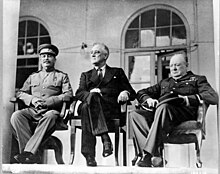
Back مؤتمر طهران Arabic Tehran konfransı Azerbaijani Тэгеранская канферэнцыя Byelorussian Тэгеранская канфэрэнцыя BE-X-OLD Техеранска конференция Bulgarian Teheranska konferencija BS Conferència de Teheran Catalan Teheránská konference Czech Cynhadledd Tehran Welsh Teherankonferencen Danish
| Tehran Conference "Eureka" | |
|---|---|
 Left-to-right: Soviet leader Joseph Stalin, American president Franklin D. Roosevelt, British prime minister Winston Churchill | |
| Host country | |
| Date | 28 November – 1 December 1943 |
| Venue(s) | Embassy of the Soviet Union |
| Cities | Tehran, Iran |
| Participants | |
| Precedes | Yalta Conference |
| Key points | |
Consensus to open a second front against Nazi Germany by 1 June 1944 | |
The Tehran Conference (codenamed Eureka[1]) was a strategy meeting of the Allies of World War II, held between Joseph Stalin, Franklin D. Roosevelt, and Winston Churchill from 28 November to 1 December 1943. It was the first of the Allied World War II conferences involving the "Big Three" (the Soviet Union, the United States, and the United Kingdom) and took place at the Soviet embassy in Tehran just over a year after the Anglo-Soviet invasion of Iran. The meeting occurred shortly after the Cairo Conference was held in Egypt for a discussion between the United States, the United Kingdom, and China from 22 to 26 November 1943. The Big Three would not meet again until 1945, when the Yalta Conference was held in Crimea from 4 to 11 February and the Potsdam Conference was held in Allied-occupied Germany from 17 July to August 2.
Although the three leaders arrived in Tehran with differing objectives, the main outcome of the meeting was a British and American commitment to opening a second front against Nazi Germany, thereby forcing it to pull military assets away from the Eastern Front with the Soviets. In addition to this decision, the Tehran Conference also addressed: the Big Three's relations with Turkey and Iran, as the former was being pressed to enter the conflict and the latter was under Allied occupation; operations in Yugoslavia and against Japan; and the envisaged settlement following the expected defeat of the Axis powers. A separate contract also saw the Big Three pledge to recognize Iranian independence.
- ^ Churchill, Winston Spencer (1951). The Second World War: Closing the Ring. Houghton Mifflin Company, Boston. p. 642.